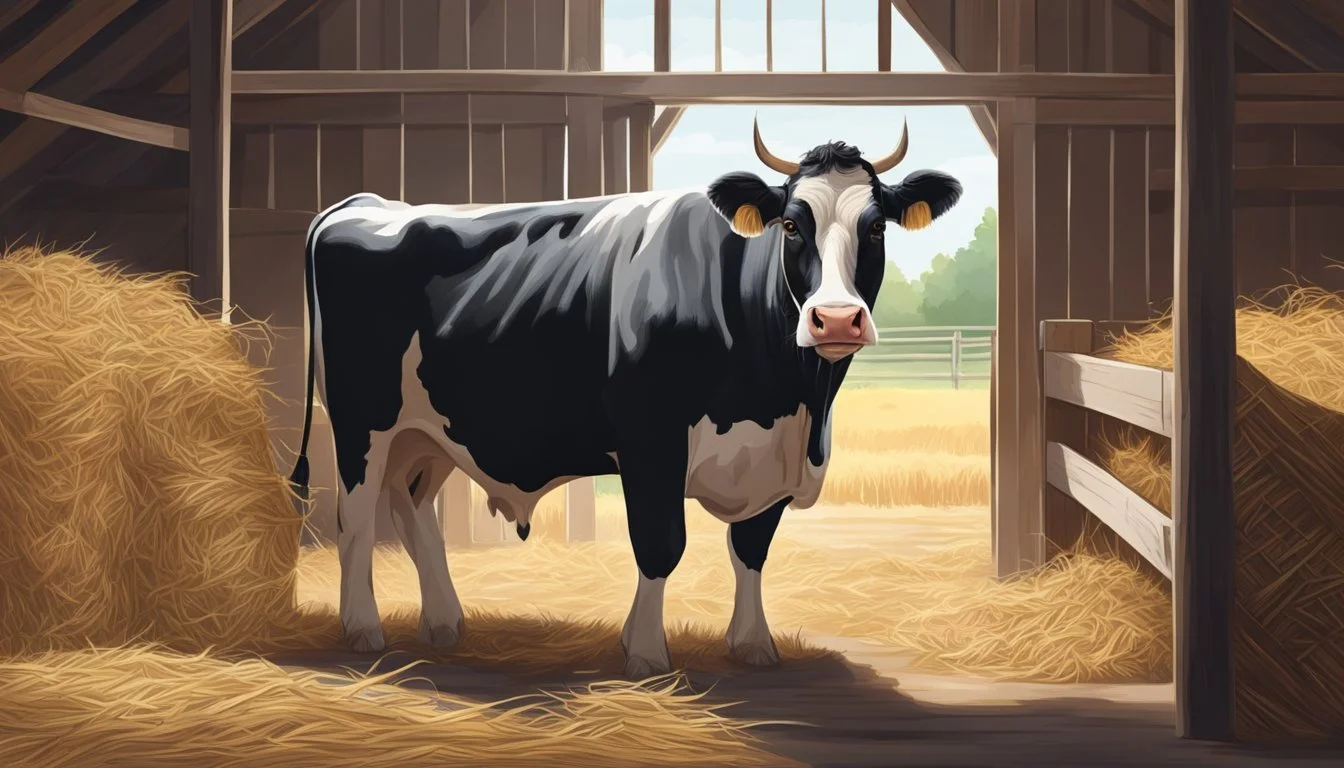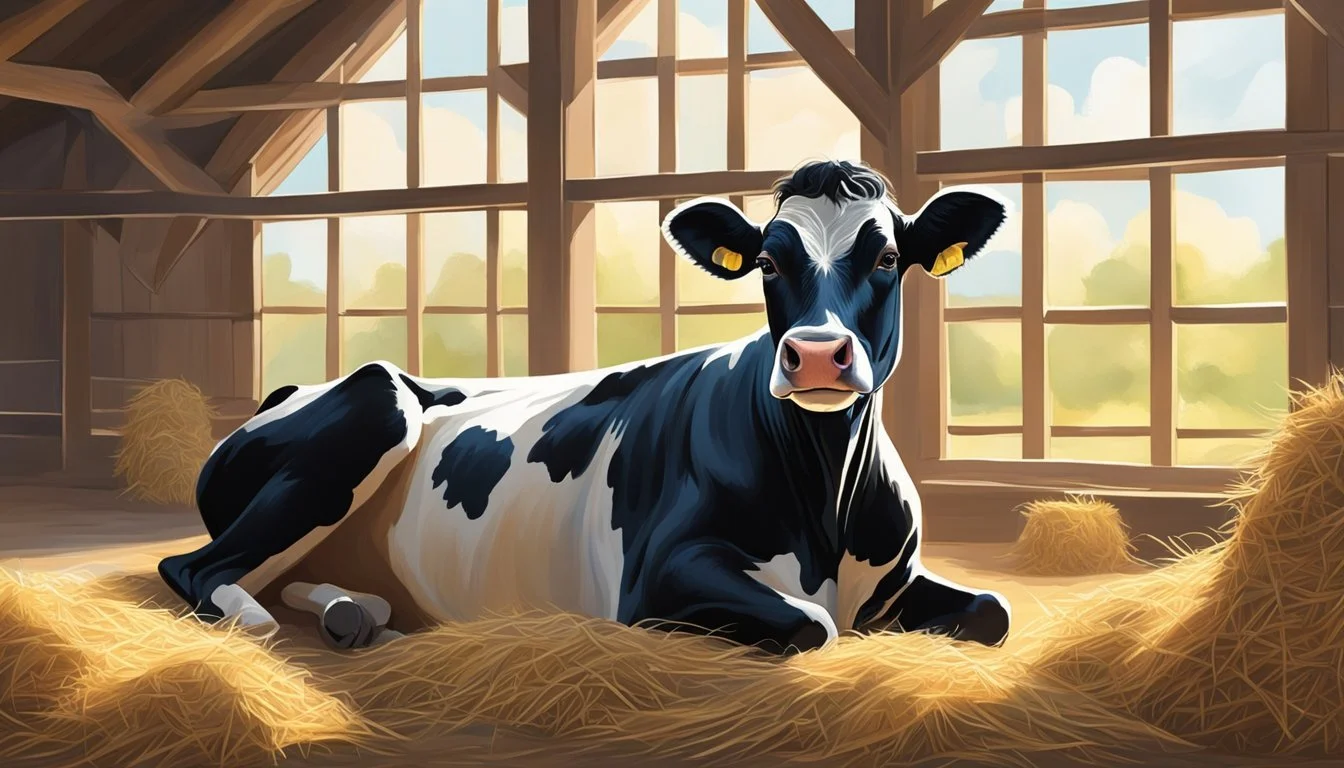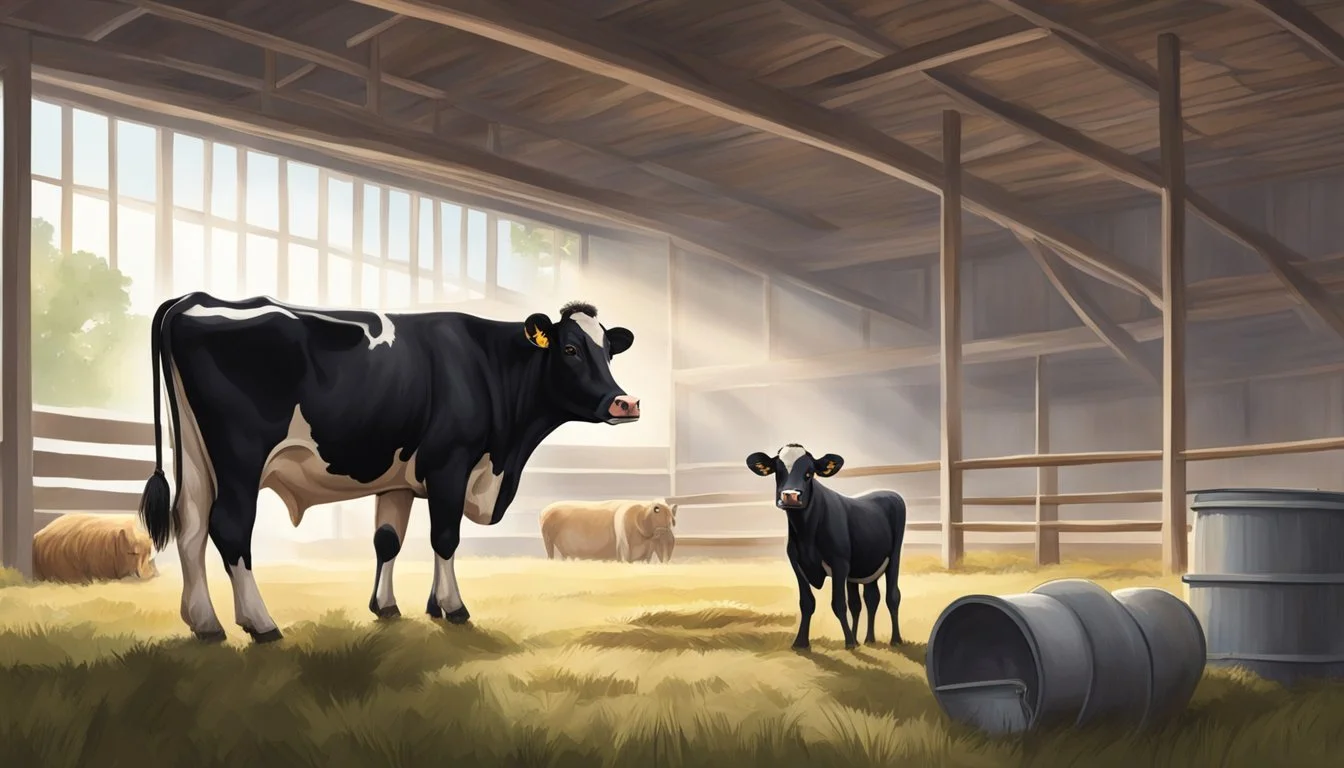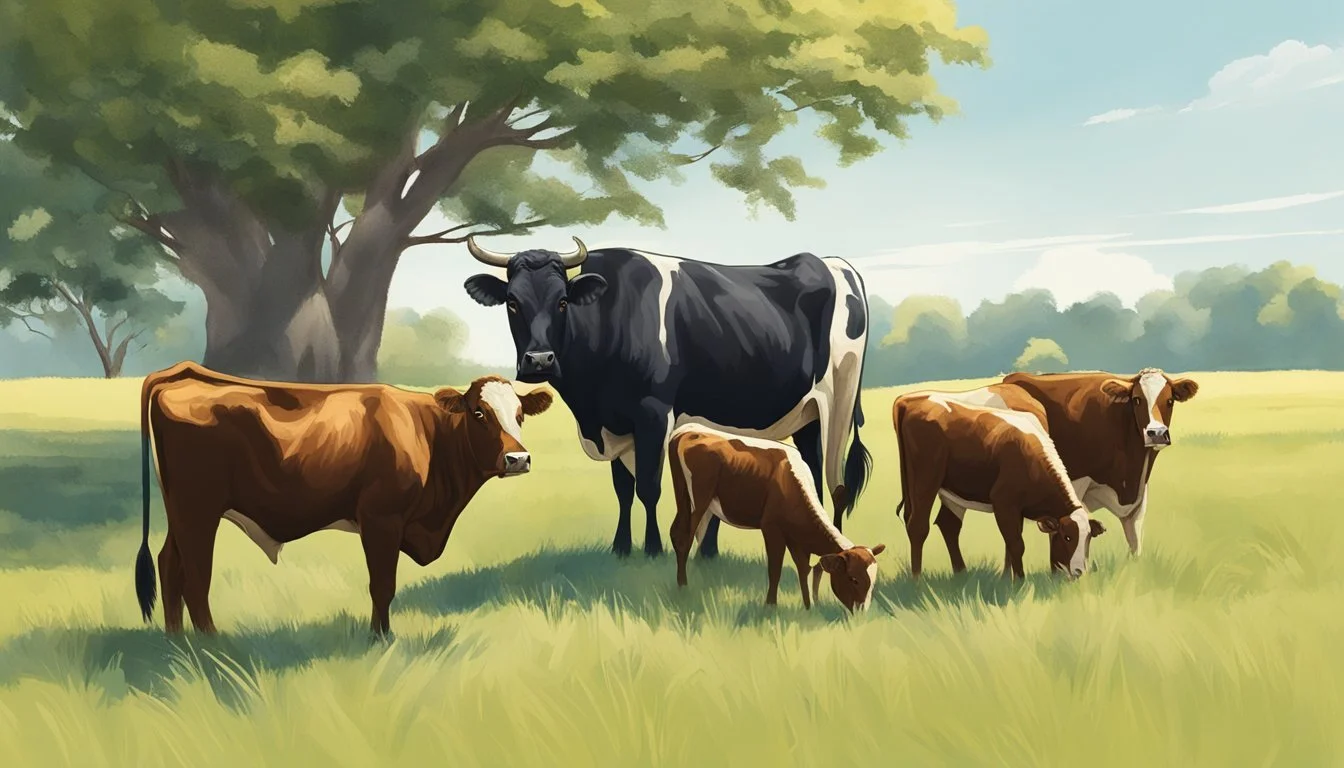Dexter Cattle Birthing Guide
Tips for Easy Calving and Efficient Management
Dexter cattle are a smaller breed of cattle that originate from Ireland, known for their hardiness, versatility, and adaptability, which makes them particularly well-suited to small-scale farming and homesteading. Their resilience across various climates and their ability to thrive on both pasture-based and supplemented grain diets lend to their popularity among farmers who have limited space but seek efficient livestock.
When it comes to birthing, Dexter cattle typically have a gestation period of around 283 days. Like other breeds, it is common for their calves to be born within a ten-day window on either side of the expected due date. Farmers and homesteaders should monitor their expectant Dexter cows closely as the due date approaches to identify the signs of labor and to be prepared to assist if necessary.
Calving is a critical time on the farm, and successful birthing is essential for the health of both the calf and the cow. The physical characteristics of Dexter cattle, including their smaller size, generally contribute to fewer complications during calving. However, proper knowledge and readiness to intervene when required can help ensure the process goes smoothly, leading to a healthy start for the newborn calf.
Understanding Dexter Cattle
Before embarking on the journey of Dexter cattle birthing, understanding the breed thoroughly can significantly influence the success of their management. This section dwells into the breed's historical roots, physical traits, breed variations, and their innate temperament and behavior.
History and Origin
Dexter cattle originate from Ireland and have been a distinct breed since the early 19th century. They were first introduced to England in 1882, when the Dexter Cattle Society was formed. Initially bred for small Irish properties, these cattle are now recognized worldwide, with organizations like the American Dexter Cattle Association and The Livestock Conservancy advocating for their preservation.
Physical Characteristics
The Dexter is a small-sized breed, well-muscled but with a more compact build than other cattle. Adult Dexters typically stand about 36 to 44 inches at the shoulder. They come predominantly in solid colors of black, red, and dun. The breed's hardiness allows it to adapt to various climates, thriving on both pasture-based diets and grain supplementation.
Breed Variations
Dexter cattle are either horned or polled (naturally without horns), a trait that has been purposely bred into some lines. There has also been a selection for two body types: the traditional short-legged and the more recent long-legged Dexter, the latter being less common.
Temperament and Behavior
Known for their even disposition, Dexter cattle exhibit a docile temperament making them favorable for small-scale farmers. They are typically easy to manage due to their size and nature. Their hardiness and adaptability also contribute to their overall easy-care demeanor, suitable for varied climates and environments.
Pre-Birthing Preparation
Preparing for the birthing process in Dexter cattle is pivotal to ensure the health and safety of both the calf and mother. Proper steps should be taken to select appropriate breeding stock, maintain health and nutrition, and set up an accommodating environment for calving.
Selecting the Right Heifer
When selecting a heifer for breeding, one should consider her physical health, genetic traits, and temperament. A well-chosen heifer has a better chance of a successful gestation and easier calving. It is important to select heifers that are large enough to handle calving, displaying good body condition, and those that have reached at least 65% of their mature weight before breeding.
Health and Nutrition
Appropriate nutrition before calving is crucial. A balanced diet ensures the cow maintains a healthy weight, reducing calving difficulties. Pregnant cows require a diet rich in energy, protein, vitamins, and minerals. Offer high-quality hay and consider feed supplements to meet nutritional needs, especially in regions where the natural forage might be deficient. A veterinarian can provide a feeding plan tailored to the cow's needs that will take into account the local climate and available feed resources.
Birthing Supplies and Environment
Preparing a clean, dry, and sheltered space for birthing helps to protect both the mother and calf. The birthing area should offer ample space, be free of hazards, and have a comfortable bedding area. Essential supplies should include clean towels, a disinfectant, gloves, and obstetrical equipment for assisted deliveries if necessary. Regular checking of the pregnant cow as her due date approaches is important to ensure timely response if calving assistance is needed.
The Birthing Process
In Dexter cattle, the birthing process entails close monitoring and timely intervention when necessary. Familiarity with the gestation period, identifying labor signs, understanding the stages of labor, and knowing when to assist are crucial for a successful calving experience.
Understanding the Gestation Period
Dexter cattle have an average gestation period of 283 days. Farmers should mark the expected due date, plus or minus 10 days, to stay prepared for the arrival of the calf. Discrepancies in the gestation length could indicate inaccuracies in the breeding date records.
Recognizing Labor Signs
As the due date approaches, Dexter cattle will exhibit signs indicative of the onset of labor. These signs inclue:
Restlessness and isolation from the herd
Swollen vulva and teats
Mucus discharge from the vulva
Udder enlargement
Labor signs imply that the cow's body is preparing for the delivery and close observation is necessary.
Stages of Labour
Calving typically progresses through three stages:
Cervix Dilation: The starting phase where the cervix dilates. This stage may last from 2 to 6 hours and is often characterized by the cow’s unease and repeated lying down and standing up.
Delivery: The second phase involves the appearance of the water bag and eventually the calf's feet and nose. This stage usually takes 1 to 2 hours. Active intervention may be needed if there are signs of calving difficulty (dystocia).
Expulsion of Afterbirth: The third stage is the passing of the placenta, which can occur from a few hours to within 12 hours after birth.
Assisting the Birth
Intervention is required if the cow is struggling and there's no progress after the membranes have ruptured. Essential equipment includes:
Clean Ropes: To aid in pulling the calf gently during contractions.
Lubricant: To reduce friction through the birth canal.
Veterinarian: Should be on call if dystocia is evident.
Calving difficulty often necessitates the presence of a professional, and timely assistance increases the likelihood of a successful birth.
Post-Birth Procedures
After the calf is born, the following procedures are important:
Clear the calf’s airways to ensure breathing is unobstructed.
Apply iodine to the navel to prevent infections.
Ensure the calf receives colostrum within the first few hours for vital antibodies.
Keep syringes ready for any necessary vaccinations or treatments as directed by a veterinarian.
Proper post-birth care is crucial for the health and survival of both the newborn calf and the mother.
Caring for the Newborn Calf
Effective care for a newborn Dexter calf is pivotal for its immediate health and long-term development. Addressing their health, nutrition, and growth from the outset optimizes their well-being and productive lifespan.
Initial Care and Health Checks
Immediately after birth, a calf's navel should be treated with a 7% tincture iodine solution to prevent infection. Observing the calf's breathing is critical, ensuring it begins within the first minute post-delivery. Health checks involve assessing the calf for any congenital issues and monitoring its ability to stand and nurse.
Feeding the Calf
Colostrum intake within the first few hours is vital for the calf's immunity. If the calf does not nurse, it may require hand-feeding with a bottle to ensure it receives this crucial nutrition. Consistent milk production from the dam should be established, with the calf feeding several times a day to support its early growth phase.
Weaning and Growth
Calf weaning typically occurs between three to six months of age, transitioning them from a milk-based diet to solid foods. Growth should be continually monitored to adjust feed accordingly, aiming for steady gains without overconditioning the calf, as Dexter cattle can be prone to obesity. Regular weighing and body condition scoring aid in tracking growth progress.
Health and Veterinary Care
Maintaining the health of Dexter cattle through proper veterinary care is paramount, especially during the birthing process. This includes understanding common health issues that may arise and ensuring routine veterinary needs are met to promote a straightforward calving experience.
Common Health Issues
Dexter cattle may experience dystocia, which is difficulty in giving birth, often due to the calf's positioning or size. This breed may also be predisposed to chondrodysplasia, a form of dwarfism, which can complicate the birthing process. It is important to monitor cows closely for signs of these conditions to address any calving difficulties promptly.
Dystocia Symptoms: extended labor, lack of progress, signs of cow distress.
Chondrodysplasia Indicators: disproportionate body structure, shorter limbs.
Routine Veterinary Needs
To ensure the health and well-being of both cows and calves, it is critical to establish a relationship with a veterinarian who understands Dexter cattle. They should be involved in:
Prenatal check-ups
Birthing plan consultations
Calving assistance, if necessary
Postnatal care
A veterinarian can also assist with regular health checks to prevent and treat issues promptly. They will be an invaluable resource if calving difficulties arise, providing professional intervention when needed.
Breeding and Genetics
In the context of Dexter cattle, understanding the genetic influences and breeding practices is essential for successful calving. Specific strategies and technologies such as Artificial Insemination contribute to the overall fertility rate, while the selection of traits ensures the propagation of desirable features in both bulls and heifer calves.
Artificial Insemination (AI)
Artificial Insemination (AI) is a pivotal tool for Dexter cattle breeders aiming to improve genetic diversity and fertility rates. AI allows for the careful selection of bulls with superior genetic traits, which can be introduced to the herd without the need to physically keep the bull on the farm. This is particularly beneficial for managing breeding programs with first-calf heifers, as it minimizes the risks associated with live breeding.
Genetic Traits and Heritability
Genetic traits in Dexter cattle are inherited from both the sire and dam. Breeders prioritize heritable traits that influence fertility, temperament, and overall health. They often focus on selecting for:
Fertility: Ensuring higher conception rates.
Size: Dexter cattle are naturally smaller, which can influence ease of birthing.
Temperament: Calm demeanor, which is crucial during calving.
Health traits: Resistance to diseases and other conditions.
Identifying and selecting these traits require an understanding of basic genetics and heritability.
Breeding Strategies
Breeding strategies for Dexter cattle incorporate:
Selective Breeding: Choosing heifers and bulls based on favorable genetics to produce the best offspring.
Rotational Breeding: Rotating different bulls with specific traits through the herd to maintain genetic diversity.
Crossbreeding: Occasionally practiced to introduce beneficial traits from other breeds, though breeder preference for maintaining the purity of the Dexter breed is common.
Breeders also consider factors such as the age of first-calf heifers and the timing of breeding to ensure the health of the mother and calf.
Management and Productivity
Effective management practices and strategic productivity measures are essential for successful Dexter cattle birthing and overall livestock productivity. This section will discuss how thorough livestock management, maximizing productivity, and optimizing pasture and feed efficiency are pivotal to achieving good birthing outcomes and productive cattle.
Livestock Management
Dexter cattle require careful management to ensure successful calving and herd productivity. One must maintain accurate breeding records to predict birthing windows, as Dexter cows typically gestate for about 283 days. Management involves regular health check-ups and providing a safe, comfortable environment for the cows to give birth. Bulls should be selected based on their genetic traits to improve the quality of the herd.
Key Management Aspects:
Monitor and record breeding dates
Schedule regular veterinary check-ups
Prepare a clean, safe birthing area
Maximizing Productivity
Productivity in Dexter cattle encompasses both dairy and beef production. For dairy, consistent milking schedules and proper nutrition are crucial to maintaining high butterfat content, which enhances the quality of dairy products. When it comes to beef production, attention should be paid to achieving excellent meat marbling through a balanced diet and adequate exercise for the cattle.
Productivity Enhancement Strategies:
Maintain a consistent milking routine
Provide a diet rich in nutrients for high butterfat milk
Manage livestock to achieve well-marbled beef
Pasture and Feed Efficiency
Efficient pasture and feed management is vital for the health of Dexter cattle and the profitability of the farm. Pasture should be rotated to maintain its quality and prevent overgrazing. Feed efficiency can be optimized by supplementing pasture with grain to meet the nutritional needs of the livestock, especially during peak lactation periods, where energy demands are higher.
Feeding Tips:
Rotate pastures to sustain grass quality
Supplement with grain to enhance nutrition
Balance feed types according to cattle's production phase
Incorporating these management and productivity techniques will aid in the seamless calving of Dexter cattle and contribute to the overall success of the herd's meat and dairy yields.
Dexter Cattle as Multipurpose Livestock
Dexter cattle are esteemed as practical livestock due to their capabilities for dairy and meat production, and their utility as draft animals, showcasing their versatility as a tri-purpose breed. These small, hardy Irish cattle efficiently fulfill multiple roles on a farm.
Dairy Production
Dexter cows are recognized for their dairy production. Although smaller in size than typical dairy breeds, they are capable of producing a satisfactory quantity of milk with high butterfat content, making their milk ideal for cheese and butter. Dexter cattle can yield around 1.5 to 2.5 gallons of milk per day, with lactation periods typically lasting 305 days. Their hardiness and minimal care requirements make them suitable for even small-scale farms.
Meat Production
As a dual-purpose breed, Dexters are also prized for their meat production. Their beef is acclaimed for its tender quality and flavorful profile. Despite their compact size, Dexters can efficiently convert feed into meat, yielding around 400 pounds of beef on average from each animal. This meat yield is highly sought after in niche markets, particularly among those looking to raise cattle on smaller plots of land.
Using Dexters as Draft Animals
Dexter cattle serve thirdly as draft animals, often referred to as oxen when trained for work. They possess the strength to perform a variety of tasks, including pulling carts and plows. While they do not match the size and power of larger draft breeds, Dexter cattle are more maneuverable and consume less feed, which can be advantageous for certain farm operations. Their small size and hardy nature make them well-suited to handling tasks on smaller farms or in tight spaces.
Practical Considerations for Small-Scale Farming
In small-scale farming, practicality is key. Farmers need efficient housing, safe handling, and breeds that bring multiple benefits to the homestead. These requirements ensure the success and sustainability of raising livestock, particularly when selecting a breed like Dexter cattle, known for their small size, docile nature, and suitability as a family cow.
Housing and Shelter Needs
On small farms, housing for Dexter cattle should be sturdy yet flexible to accommodate the shifts in weather. Winter housing, for instance, requires:
Insulation: To maintain a temperature that prevents freezing.
Ventilation: To reduce moisture and prevent respiratory issues.
During warmer seasons, shelters protect animals from heat and rain. A basic shelter can typically include:
A roof for shade and rain protection.
Open sides for airflow during hot weather.
Shelters are essential for the health and comfort of cattle, particularly around calving season to give cows and their calves a safe and secure environment.
Handling and Restraint
Dexter cattle's small size and docility make them easier to handle than larger breeds. Key considerations for safe handling include:
Halters: Essential for leading and restraining cattle for routine checks and medical treatment.
Use of a squeeze chute or head gates to safely secure the cattle during more intensive procedures.
Farmers must ensure that handling facilities are appropriately scaled for the size of Dexter cattle to prevent injury and minimize stress.
Breed Advantages for Homesteads
Dexter cattle are often termed as the "poor man’s cow" because of their multiple advantages for homesteads:
Dual-purpose: They are suitable for both milk (dairy) and meat production.
Their small size means more cows per acre, optimizing the use of land.
Dexters can be raised on pasture-based diets with the option for grain supplementation.
These characteristics make Dexters especially attractive for small-scale farmers looking to maximize their resources while ensuring the welfare of their animals.
Ethical and Sustainable Farming Practices
In the realm of Dexter cattle birthing, ethical and sustainable practices are paramount for the wellbeing of livestock and the environment. These methods underscore a commitment to humane treatment and ecological balance.
Breeding Ethics
Ethical breeding begins with the selection of healthy animals that are genetically suited to their environment. It is crucial to avoid inbreeding and to perform regular health checks to ensure the welfare of the cattle. Proper management during breeding includes separating bulls from cows post-breeding to prevent injury and stress, and to control the calving period, aiming for spring or summer births when conditions are more favorable for the newborns.
Environmental Sustainability
Sustainability in Dexter cattle farming involves the implementation of practices that minimize the carbon footprint and promote the regeneration of ecosystems. Farms are encouraged to:
Rotate grazing areas to prevent land overuse and maintain soil health.
Utilize pasture-based diets, reducing the need for synthetic feeds.
Minimize the use of chemical inputs like fertilizers and pesticides by adopting natural farming methods.
Ensuring environmental sustainability contributes to the resilience of the livestock and the surrounding habitats.
Cultivating a Humane Livestock Community
Building a humane livestock community entails creating conditions where animals can exhibit natural behaviors. Key aspects include:
Providing ample shelter and comfort to protect against extreme weather.
Ensuring calves have adequate space and cover, nurturing a stress-free environment for both mother and offspring.
Adopting a community-focused approach where farmers share knowledge and practices that promote animal wellbeing and ethical treatment across homesteads, farms, and ranches.
To summarize, ethical breeding, environmental sustainability, and fostering a humane livestock community are integral to the responsible raising of Dexter cattle. These practices strengthen the bond between farmers and their livestock, support longevity and health of the animals, and protect the earth's natural resources.
Community and Resources
In the realm of Dexter cattle breeding, a supportive community and a wealth of resources are invaluable for both novice and experienced breeders. These collectives provide essential knowledge, support, and networking opportunities to ensure successful calving and herd management.
Breed Associations and Societies
American Dexter Cattle Association (ADCA) and The Dexter Cattle Society are two pivotal organizations serving Dexter cattle owners. The ADCA offers extensive information on breeding standards, registration processes, and genetic testing resources. They also organize events where owners can exhibit their cattle and exchange breeding insights. Across the pond, The Dexter Cattle Society provides similar support in the UK, focusing on the heritage and preservation of the Dexter breed.
American Dexter Cattle Association (ADCA)
Registration and Standards
Genetic Testing Resources
Member Events and Exhibitions
The Dexter Cattle Society
Breed Preservation
UK Focused Support and Guidance
Official Dexter Registries
Educational Resources and Networking
Educational resources play a crucial role in calving and herd management. Breed associations typically offer a plethora of guides, bulletins, and articles addressing common questions about Dexter cattle birthing and care. For hands-on learning, local agricultural extension programs can be a treasure trove of workshops and classes. Networking within the community, such as through ADCA or local farming groups, can lead to mentorship opportunities and sharing of best practices.
Workshops and Classes via Agricultural Extensions
Informative Guides and Bulletins
Networking Events for Dexter Cattle Enthusiasts
Support for Dexter Cattle Owners
The community surrounding Dexter cattle provides an array of support systems for breeders. Experienced owners often extend mentorship to newcomers, guiding them through the calving process. Online forums and social media groups dedicated to Dexter cattle act as platforms for breeders to seek advice and share experiences. Whether facing uncertainties about calving or looking for tips on herd management, the support from these groups can be invaluable.
Mentorship from Experienced Breeders
Online Forums and Social Media Groups
Collective Knowledge Sharing
Conclusion
Raising Dexter cattle can be a rewarding endeavor given their small stature and dual-purpose attributes. As breeders approach the anticipated birthing period, they should be prepared for a gestation that typically spans 283 days. It is prudent to mark the calendar for 10 days before and after the expected due date to ensure close monitoring.
Prospective Challenges:
Calving Difficulty: Despite their size, Dexter cattle may sometimes face challenges during calving, possibly requiring human intervention.
Gestation Variability: Bull calves often have slightly longer gestation periods compared to heifer calves.
Preparation Steps:
Monitor closely as the due date approaches.
Prepare for intervention if the birthing process stalls.
Farmers must be ready to assist if complications arise. Familiarity with calving signs and processes, plus immediate access to veterinary resources, elevates the likelihood of a successful calving experience. Proactive measures and a caring approach can mitigate most calving difficulties.
Post-Calving Care: Ensuring the health of both calf and cow post-birth is crucial. This includes vigilant observation, adequate nutrition, and a clean birthing environment.
In summary, knowledge is pivotal to the successful rearing of Dexter cattle. Dexter breeders should continuously seek knowledgeable resources and best practices in order to refine their approach to cattle raising. A blend of preparation, observation, and swift action forms the cornerstone of effective Dexter cattle birthing management.







